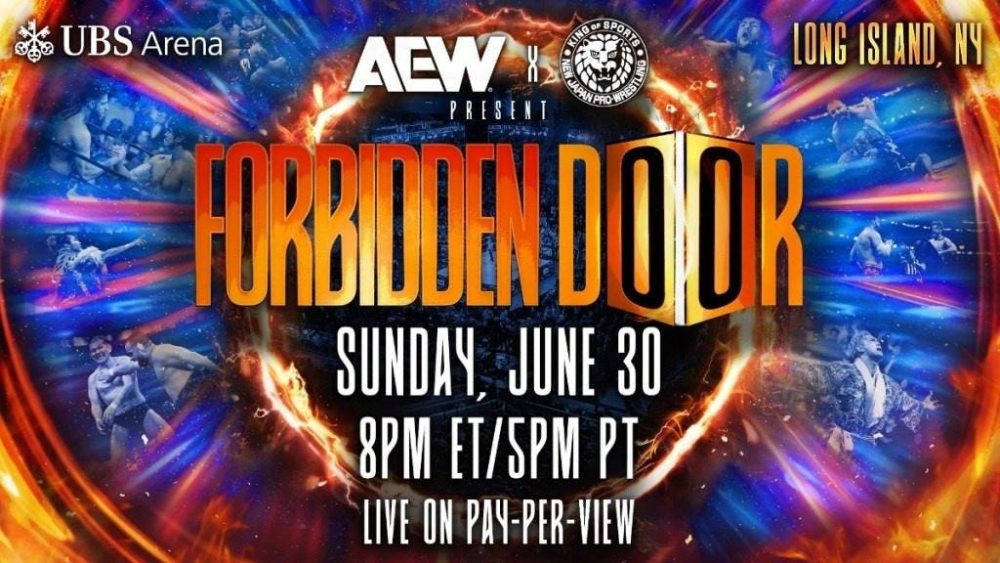

Tony Khan loves making each showing of his wrestling promotion an event unto itself. It often feels like we’re getting a “special’ edition of Dynamite or Collision every other week. It can cheapen the experience somewhat as there’s not a lot of room for hype and buildup as they keep churning out these mini events at such a breakneck pace.
There is one event that does feel like a big deal, with unique matchups that reward those in the know regarding international wrestling: Forbidden Door. Comprising of a crossover between AEW, NJPW, and Mexico’s own CMLL, this year’s edition gave us a series of great matches that culminated with a new classic in the form of Swerve Strickland vs. Will Ospreay. While the end result was not the 5-star mega event it wanted to be, it did have a few standout matches that AEW can build from to give its roster a more cohesive sense of narrative moving forward (something it desperately needs).
What’s apparent with Forbidden Door, thanks to the buzz it gets online as the final card starts making the rounds and the anticipation it builds as a convergence of wrestling cultures, is that AEW should make this their marquee event. More so than All In at Wembley Stadium or Grand Slam at the Arthur Ashe in NYC. It’s what separates Khan’s wrestling project from the WWE, though that window of opportunity seems to be closing fast as Triple H seems invested in bring the fight to that doorstep as well.
Simply put, Forbidden Door can become AEW’s own Wrestlemania. It has the potential to be the event you spend a year building up to. Rivalries, title challenges, tournaments, all of this can be recalibrated to serve as the foundation for what should be one of wrestling’s biggest nights at an international level.
So far, it’s one of the year’s most explosive events, but it’s not at Wrestlemania levels yet. In fact, it has a ways to go because of one glaring weak point AEW has struggled with almost since its inception: a lack of extended and continuing storylines.
Of the matches that played out during this year’s event, there were around three of four that had some momentum going for them because they had story built into them. Perhaps the most notable was Toni Storm vs. Mina Shirakawa (currently signed to Stardom). Fighting for the hand of Mariah May in a Queer-coded rivalry that would smartly get resolved at the end of Pride Month (June 30th, 2024), Toni and Mina spent weeks trying to upstage each other to claim May as theirs. Mina in particular won over the crowd quite quickly, garnering a strong following despite Storm’s overwhelming popularity in the company.
Mina lost in a match that had its moments but was relatively quiet throughout. With it, a considerable amount of storytelling was wasted on a resolution that saw May brokering a not-so-subtle three-way after she stepped in to tell them she wanted them both beside her. They shared a triple kiss and off they went to sexlebrate the night.
This was a lost opportunity. Had Mina won, her rivalry with Storm could’ve moved on to a more intense phase where May’s affection could still be on the line but with more suitors or jilted exes stepping in. There was so much story tell, but AEW chose to close that door right then and there. May has now betrayed Storm and is setting up an inevitable match in the near future against her after she won the Owen Hart Foundation Tournament. Mina has faded from the spotlight she helped make so bright in such a short time at AEW.
Swerve and Ospreay had a few weeks of back and forths before FD, ranging from a friendly challenge between two of the greatest talents in wrestling to a fiery rivalry where both cut promos ramping up their obsessions to be crowned the best in the world. The match delivered on all fronts, though the driving force was the showcase of abilities we were guaranteed to get come showtime.
The crowd really wanted to see this one, and the energy was palpable. Swerve took the win, but it was really a great night for both of them as they further cement their argument as this generation’s top performers. Unfortunately, this was yet another missed opportunity to build upon story. This is the type of dream match you take your time with. The WWE excels at this. Delayed gratification works if the necessary legwork is put in to assemble a narrative that can go the distance. The main event of a massive event shouldn’t be put together a month and a half beforehand. It deserves time to breathe, grow, expand, change direction, and then refocus for maximum effect.
And then you had a very special match that made a star out of one of its participants but fell apart at the end by not taking a risk and going with a different finish. This is what happened with Mercedes Moné vs. Stephanie Vaquer. Again with little buildup, Vaquer came out to challenge Moné a short time before FD, armed only with a rapidly growing fanbase and an impressive sense of presence to carry her through. Vaquer is a generational talent, a wrestler that performs as if each match were her last. She possesses a very distinct kind of physicality that works both on a high-flying lucha level and on a more methodically paced level.
Problem was, you only knew about Vaquer if you followed her on socials and were already paying attention to the stuff coming out of CMLL and NJPW. She’s the first luchadora to hold both the World Women’s Championship belt and the World Women’s Tag Team belt at CMLL (both of which she vacated to sign with WWE and go to NXT). She has fans all over the world, but it’s not a given she has that in the US. You still have to give these types of wrestlers the time to take the stage and make their cases on why they’re here to take over their divisions.
Instead, Moné beat her unconvincingly (gotta love that creative control clause, right?) and then, shortly after, AEW got outplayed by the WWE and lost the chance to sign her. The biggest mistake made here is thinking every fan is up to date on every foreign promotion and their rosters. Again, not a given. Star power doesn’t automatically bleed over if the wrestler hasn’t been exposed to the public before. By going to the WWE, Vaquer has one of the best opportunities to become a household name. She’s in a company that knows how to create superstars.
So, how can AEW turn Forbidden Door into their own Wrestlemania-level event? The answer is so simple it hurts. SPEND TIME DEVELOPING STORYLINES. Forbidden Door can be one of the most beautifully complex storytelling endeavors in wrestling, with cross-promotion narratives that slowly build to the event. The quality matches are there. The talent is there. Give all of that something worth following week in and week out to then see resolved in what should be the biggest wrestling event of the year. Forget the weekly ratings war. Aim for a Forbidden Door-Wrestlemania War.
More than a sport, wrestling is a storytelling medium. The path to success lies in getting fans invested in the trajectories their favorite wrestlers take to fulfill their dreams, be it of becoming champions or of exacting revenge. The moment AEW commits to this is the moment the game changes.
Related





